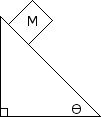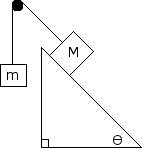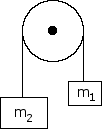Physics 1: Free Body Diagrams
As shown in the figure, two blocks with masses m and M (M>m) are pushed by a force F in both Case I and Case II. The surface is horizontal and frictionless. Let R1 be the force that m exerts on M in Case I and RII be the force that m exerts on M in Case II. Which of the following statements is true?

Two boxes with masses 17 kg and 15 kg are connected by a light string that passes over a frictionless pulley of negligible mass as shown in the figure below. The surfaces of the planes are frictionless. The blocks are released from rest. T1 and T2 are the tensions in the strings. Which of the following statements is correct?

An Object with mass m and initial velocity v is brought to rest by a constant force F acting for a time t and through a distance d. Possible expressions for the magnitude of the force F are: i. ii. iii.
ii only
iii only
i and ii only
ii and iii only
i, ii, and iii
A toy car of mass 6 kg moving in a straight path, experiences a net force given by the function F = -3t. At time t=0, the car has a velocity of 4 m/s in the positive direction and is located +8 m from the origin. The car will come instantaneously to rest at time t equal to
2/3 s
sqrt( 4/3 ) s
sqrt( 8/3 ) s
sqrt( 8) s
4 s
A block of mass M1 on a horizontal table is connected to a hanging block of mass M2 by a string that passes over a pulley, as shown in the figure below. The acceleration of the blocks is 0.6g. Assume that friction and the mass of the string are negligible. The tension T in the string is

In the situation above, what is the ratio of the masses?
0.67
1.0
1.4
1.5
1.6
Hercules and Carlos horizontally push in the same direction on a 1200 kg crate. Hercules pushes with a force of 500 N and Carlos pushes with a force of 300 N. If a frictional force provides 200 N of resistance, what is the acceleration of the crate?
1.3 m/s2
1.0 m/s2
0.87 m/s2
0.75 m/s2
0.5 m/s2
Two sleds are attached by a rope and are being pulled by an applied force, Fa= 100 N. There is 40 N of frictional force opposing movement on each sled. Draw a free body diagram to help find:

Determine the acceleration and the value of the normal force. Draw a free body diagram.

M = 10kg, = 30 degrees
A block of mass M = 5kg is placed on an incline of = 30 degrees. There is a frictional force of 15 N opposing the movement of the block. Determine the acceleration of the block. Draw a free body diagram to help find the answer.

A block of mass M = 5kg is placed on an incline of = 30 degrees. There is a frictional force opposing the movement of the block with a coefficient of friction, = 0.2. Determine the acceleration of the block. Draw a free body diagram to help find the answer.

Determine the acceleration of the system if M = 10 kg and m = 30 kg and = 30 degrees. Determine the tension in the rope as well.

Determine the acceleration of the system if M = 5 kg and m = 10 kg and = 30 degrees. There is also a coefficient of friction, = 0.2. Use a free body diagram to determine the tension in the rope and the acceleration of the system.

The large block M is 20 kg, and the smaller block, m, is 1 kg. The coefficient of kinetic friction is 0.2. Determine the acceleration of the system and the tension in the cords. The angle of the inclined plane is 60 degrees to the horizontal. Also draw a free body diagram for both blocks.

Block M = 5 kg and block m = 6 kg. The coefficient of friction is 0.5. Determine the acceleration of the system and the tension in the cord. The angle of the inclined plane is 20 degrees to the horizontal. Draw a free body diagram for the 5 kg block to help find the answer.

Block M = 5 kg and block m = 3 kg. The coefficient of static friction is 0.2. Determine the acceleration of the system and the tension in the cord. The angle of the inclined plane is 30 degrees to the horizontal. Draw a free body diagram for the 5 kg block to help find the answer.

Determine the acceleration of the system if m = 5 kg and m = 10 kg and the pulley has no mass. Determine the tension in the rope as well.

Determine the acceleration of the system if m = 3 kg and m = 8 kg and the pulley has no mass. Determine the tension in the rope as well.

Determine the acceleration of the system if m = 5 kg and m = 10 kg and m. Determine the tensions T, T , and T .

A 3 kg box is pushed on a surface with a force of F = 15 N. The coefficient of static friction, is 0.3, and the coefficient of kinetic friction, is 0.1.
A. Does the box move?
B. If it does move, calculate the acceleration of the box.